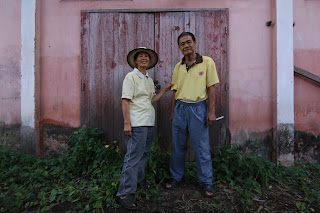In northern Thailand, precious little of a stand-alone cinema culture remains intact. Of all the 16 provinces classified as the north, there are a meager two stand-alone theaters still operating, both of which are owned by Thana Cineplex, a subsidiary of Pra Nakorn Films. That's a paltry number considering that over the years there have probably been around 100 movie theaters in Thailand's north.
With no business to host, demolition has been the norm among this dead facet of popular culture. As a rule of thumb, the older the theater, the less likely it is to be standing today. This formula has ensured that in all my northerly expeditions I have only encountered one theater built prior to the 1960's. They're simply hard to come by.
This past November, a second granddaddy was added to the list. Following a tip, I motored over to Hang Chat district, Lampang in search of the Sri Nakorn Paphayon.
The Sri Nakorn Paphayon
The Sri Nakorn Paphayon faces onto Hang Chat's main thoroughfare, diverging architecturally from the avenue's other structures by little more than the free-standing signage perched at its summit. Main street's visual uniformity has a soothing aspect to it, retaining the aesthetic conservatism of mid-20th century provincial Thailand. The inventory of buildings is composed of a discernibly older stock than most small towns in the Thai north, a fact that was all but confirmed by the Sri Nakorn's welcoming owners.
Thongsuk (right) and Rampeung Weehayanwut, owners of the abandoned Sri Nakorn Paphayon, standing in front of the theater's side entrance.
Thongsuk Weehayanwut and his wife Rampeung have looked after the Sri Nakorn Paphayon since they inherited it from Thongsuk's father. In reality, however, the "looking after" they do these days is not very involved. In the eyes of Thongsuk, his inheritance is a bit of a white elephant.
The Weehayanwut's property in Hang Chat is expansive. Entering through a driveway beside the old theater leads to their industrial/residential compound, comprised of a furniture factory reminiscent of an air plane hanger, an equally large warehouse for lumber, a modest single-story office house and the family's idyllic sino-colonial style abode, appearing feudal among the towering stands of teak.
Occupying the most commercially viable plot of land on the property is the abandoned theater, which the Weehayanwut's generously gave me a tour of.
In the theater's active years, this ticket window area was an open-air veranda, but the owner sealed it up once the theater closed.
Ticket windows and perforated masonry.
"It was an economic failure from the beginning," conceded Thongsuk, as we stumbled across the theater's debris-strewn auditorium. "My father envisioned this as being Hang Chat's most popular destination, but it didn't work out that way."
Thongsuk's father opened the Sri Nakorn Paphayon as Hang Chat's first ever movie theater in 1957. Powering the theater by diesel generator in a time when residential electricity was reserved for wealthy urbanites, the senior Weehayanwut expected brisk ticket sales from a townsfolk lacking in entertainment options. He miscalculated.
For all intents and purposes, Hang Chat is a suburb of the much larger and economically dynamic provincial capital, Lampang. Travel between the two has been simple and unobstructed ever since the railroad connected them in the early 1920's. As a result, Thongsuk explained, "we were never able to attract large crowds, because by the time a film made its way up here, all the townsfolk and people from the surrounding villages had already gone to see it at one of the bigger theaters in Lampang."
Ticket window ironwork.
The auditorium of the Sri Nakorn Paphayon. The ceiling rafters are made of timber, as are all doors and windows. The walls of the structure are made of poured concrete.
Projection room given over to storage.
The Weehayanwut's closed down the perennial money pit about 40 years ago without ever attempting to repurpose it. Today, it sits on the side of the road in the heart of old Hang Chat, serving as a barrier to the rest of their property and not much else.
"Frankly, if I had an opportunity to replace it with a 7-11 or Tesco-Lotus, I'd tear it down," admitted Thongsuk. "But I haven't been able to find a good tenant for the land."
Signage
Just a thought, but 7-11 or Tesco-Lotus might be able to ever so slightly improve their corporate image if one of them moved in, rehabbed the front portion and used it for retail.
Better yet, being that coffee shops are all the rage across northern Thailand these days, the street side portion of the building, consisting of the veranda and the space above, would make a most salubrious place to sip a brew.
Noting that a) it matches architecturally with most of the other old building on the street, b) its structural integrity is sound, c) its identifying details like the original free-standing signage is intact and d) (in certain regards) it's a local landmark, there's no reason to tear it town.










No comments:
Post a Comment